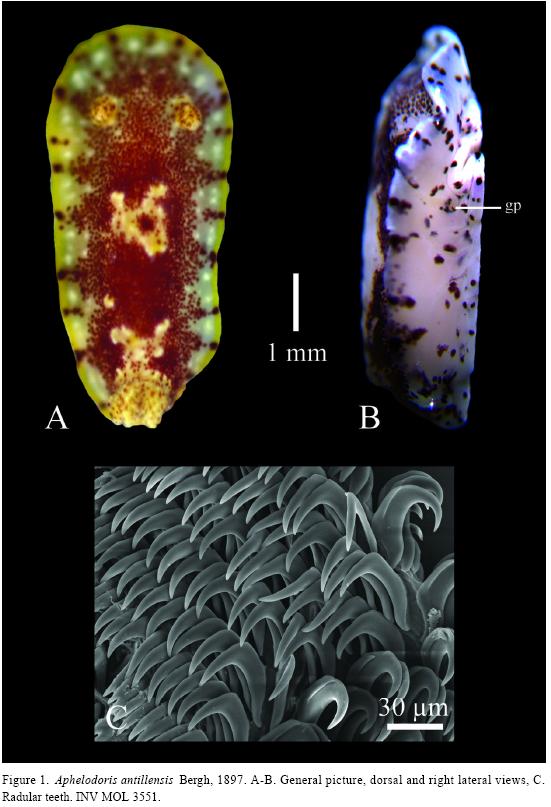Services on Demand
Journal
Article
Indicators
-
 Cited by SciELO
Cited by SciELO -
 Access statistics
Access statistics
Related links
-
 Cited by Google
Cited by Google -
 Similars in
SciELO
Similars in
SciELO -
 Similars in Google
Similars in Google
Share
Boletín de Investigaciones Marinas y Costeras - INVEMAR
Print version ISSN 0122-9761
Bol. Invest. Mar. Cost. vol.33 no.1 Santa Marta Jan./Dec. 2004
NOTE:
Aphelodoris antillensis BERG, 1897 (OPISTHOBRANCHIA: NUDIBRANCHIA: DORIDIDAE), FIRST RECORD FROM THE COLOMBIAN CARIBBEAN
Aphelodoris antillensis Berg, 1897 (Opisthobranchia: Nudibranchia: Dorididae), primer registro del Caribe colombiano.
Sigmer Quiroga, Néstor E. A rdila and Marcela Bolaños
RESUMEN
Aphelodoris antillensis B e rg, 1897 es una especie ampliamente distribuida en el mar Caribe. El especimen examinado fue colectado en el litoral rocoso de la Bahía de Neguanje, cerca de Santa Marta, siendo esta la primera vez que se registra este género en el Caribe colombiano.
PALABRAS CLAVE: Opisthobranchia, Nudibranchia, Caribe, Litoral rocoso, Colombia.
The Nudibranchia, often considered to be the crown group of the Opisthobranchia with probably 3000 species, is a taxon that is distributed worldwide in all oceans from the intertidal down to the deep sea (Wollscheid and Wägele, 1999). Seventeen species of nudibranchs have to date been recorded in the Colombian Caribbean (Díaz and Puyana, 1994; Ardila and Díaz, 2002). A to date unrecorded species of the genus Aphelodoris (Family Dorididae) in colombian waters was recently collected near Santa Marta, which is hereby recorded and described.
Aphelodoris antillensis Bergh, 1897
(Figure 1)
Aphelodoris antillensis B e rgh, 1897, p. 92 (Marcus and Marcus, 1967)

Material: One specimen, Playa Cristal (11°19' N, 74°04' W), Santa Marta, Colombia; rocky shore; 5.9 mm long, 3.4 mm wide preserved, INV- MOL355 1.
The living specimen is approximately three time as long as wide. Alive animal has a lot of opaque white and dark brown spots, the dark brown spots often aggregated into l a rger patches, which are more concentrated in the middorsal region. The opening of the anal gills is yellow colored all around and in the central region of the animal there is a yellow blotch. Toward the margins, the animal has a translucent band with numerous white dots. The margin is yellow, discontinued irregularly by dark reddish brown perpendicular lines. Hyponotum milky white flecked and spotted with brown (Figure 1A, B).
The border of the notum is thin and the tail pointed. The foot is rounded in front and its tail is projected. The white-tipped, lamellate rhinophores are yellowish, with some brown spots, and are retractable into a raised sheath. The five thickened gills are also yellowish, becoming white at the tips, and are sparsely spotted with brown (Figure 1A). The oral tentacles are short and blunt. The species grows to about three cm in length.
The radular formula is 30 x 43.0.43. in the single specimen examined; all teeth are hook-shaped and without denticles (Figure 1C).
The color pattern of the type material is not known. Humann (1992) described the color variation to be found in this species. Though the coloration can differs a little between specimens found in different places, the color pattern generally is the same and these variations are intraespecific. In some specimens there is a yellow border, which could be considered as a juvenile characteristic. The radular formula also differs a little of the specimens described by Marcus and Marcus (1967) and Meyer (1977). However it must be considered that the size of the specimen reported is less. This species is able to swim by means of violent contractions of the body, its habitat is the intertidal zone, where it is usually found on hard substrates.
ACKNOWLEDGEMENTS
Thanks to Ángel Valdés and Jennifer Murphy (Natural History Museum of Los Angeles County) for their invaluable assistance in the SEM laboratory.
REFERENCES
Ardila, N. E. and J. M. Díaz. 2002. Armina juliana (Nudibranchia: Arminoidea: Arminidae) a new species from the southern Caribbean. Bol. Inv. Mar. Cost. 31: 25-31.
Díaz, J. M. and M. Puyana. 1994. Moluscos del Caribe colombiano. Un catálogo ilustrado. Colciencias- Fundación Natura-Invemar, Santafé de Bogotá, 291 p.
Humann, J.C. 1992. Awarm water Atlantic synonymy, Aphelodoris antillensis equals C h romodoris bistellata (Opisthobranchia: Gastropoda). The Veliger, 35(3): 215-221.
Malacolog 3.2.2. 2003. Western Atlantic Gastropod Species Database at The Academy of Natural Sciences of Philadelphia, http://data.acnatsci.org/wasp/
Marcus, E and E. Marcus. 1967. American Opistobranch Mollusks. Studies in Tropical Oceanography. 6: viii + 256 pp. Institute of Marine Sciences, University of Miami. USA.
Meyer, K. 1977. Dorid Nudibranchs of the Caribbean Coast of the Panama Canal Zone. Bull. Mar. Sci., 27 (2): 299-307.
Wollscheid, E. and H. Wagele. 1999. Initial results on the molecular phylogeny of the Nudibranchia (Gastropoda, Opisthobranchia) based on 18S rDNAdata. Molec. Phylogen. Evol., 13 (2): 215-226.
DATE RECEIVED: 21/07/03 D ATE ACCEPTED: 06/02/04
ADDRESSES OF THE AUTHORS:
Department of Zoology, University of New Hampshire, Durham, New Hampshire 03824, USA, E-mail: squiroga@cisunix.unh.edu (S.Q.), E-mail: dbolanos@cisunix.unh.edu (M.B.). Museo de Historia Natural Marina de Colombia, Instituto de Investigaciones Marinas y Costeras (INVEMAR), A.A.1016, Santa Marta, Colombia. E-mail: nardila@invemar.org.co (N.E.A). 258 259 Figure 1. Aphelodoris antillensis Bergh, 1897. A-B. General picture, dorsal and right lateral views, C. Radular teeth. INV MOL 3551.













